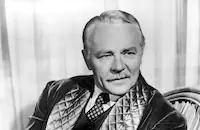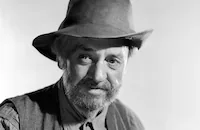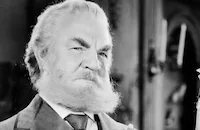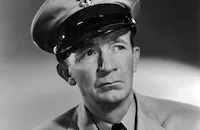Murder in the Private Car

Brief Synopsis
Cast & Crew
Harry Beaumont
Charles Ruggles
Una Merkel
Mary Carlisle
Russell Hardie
Porter Hall
Film Details
Technical Specs

Synopsis
In Los Angeles, telephone operator Ruth Raymond learns from lawyer Alden Murray that she actually is the long-lost daughter of railroad magnate Luke Carson. Carson had been kidnapped as a toddler by his vengeful brother and business partner Elwood and reared in obscurity by strangers. Soon after Ruth is established as an heiress, her bodyguard and chauffeur attempt to kidnap her, but are foiled by the arrival of the mysterious Godfrey D. Scott, who deliberately punctures the kidnappers' gas tank while Ruth is meeting with her boyfriend, John Blake, in a park. After the failed kidnapping, a telegram from Carson, in which he tells Ruth that he is meeting her in Los Angeles, is intercepted and replaced by a telegram that advises Ruth to take the train to New York. As Ruth, her best friend Georgia Latham, and Murray board the private car of one of her father's east-bound trains, John rushes to warn Ruth about the trip, but is chased away by the police. Soon after the train leaves, the lights go out in Ruth's car, and she finds a note that reads "eight hours to live." At that moment, Scott announces his presence on the train and introduces himself to the group as a "de-flector," a sleuth who prevents crime. While Scott defends himself to the doubting Ruth, Georgia and Murray, a train porter is thrown from the train by an unseen assailant. Allen, Ruth's adoring former boss, then storms into the car and, aware that Carson is not in New York, accuses Murray of duplicity and insists that Ruth is not Carson's daughter. After quieting Allen, Scott reunites stowaway John with Ruth, and romances Georgia until the train is stopped suddenly by a circus wreck on the tracks. While the wreck is cleared, a gorilla escapes from its cage and sneaks into Ruth's car. Later, Murray is stabbed to death, and a voice announces that the remaining private car passengers only have five hours to live. The gorilla then attacks Ruth and Georgia and finally jumps from the train after attacking a terrified Scott. The next morning, the train stops in a small southwestern town, where Carson had been told through a strange radio message to meet up with Ruth. After father and daughter enjoy a happy reunion, they re-board the private car and resume their journey. Suddenly all of the windows are blackened one by one, and the mysterious voice tells the frightened passengers to "say their prayers." Carson finally recognizes the voice as that of his brother Elwood, and once identified, Elwood explains that as revenge for Carson's previous defrauding, he has planted explosives on the private car and uncoupled it so that it is now on a collision course with an east-bound train. As the train hurtles backward through the mountain divide, Scott overwhelms and kills Elwood, who is revealed to be in the disguise of Hanks, a porter, then radios the other fast-approaching train. After a long and treacherous trip, the private car avoids the collision, and all of its passengers are transferred safely to another train.

Director

Harry Beaumont
Cast

Charles Ruggles

Una Merkel

Mary Carlisle
Russell Hardie

Porter Hall
Willard Robertson

Berton Churchill
Cliff Thompson
Snowflake
Harry Semels

Akim Tamiroff
Ray Brown

Sterling Holloway
Charles Dunbar
John David Horsley

Lee Phelps
Ernie Adams
William Nye

Wilfred Lucas
Jack Baxley
Hooper Atchley
James Warwick
Standing Bear
Nick Copeland
Jack Cheatham
Bud Ernest
Olaf Hytten
James P. Burtis

Walter Brennan
Ray Corrigan
Naba
John Kelly
Art Beery Sr.
Crew
Al Boasberg
Fred Gabourie
Cedric Gibbons
William S. Gray
Lucien Hubbard
Harry Sharrock
Douglas Shearer
Leonard Smith
Ralph Spence
Earl Taggert
Harvey Thew
David Townsend
James Van Trees
Charles Wallace
Edwin B. Willis
Edgar Allan Woolf

Videos
Trailer
Hosted Intro
Film Details
Technical Specs

Articles
Murder In the Private Car - Murder in the Private Car
Mary Carlisle, a capable but undistinguished starlet who never got her breakthrough role, plays switchboard operator and office sweetheart Ruth Raymond. She's just your average young working girl in New York with a nice boyfriend (Russell Hardie) and a smart-aleck but stalwart best friend (Una Merkel), until a private detective reveals that Miss Raymond is really Ruth Carson, the long-lost daughter of a millionaire railroad magnate. With whiplash speed, Ruth is whisked away to a five start hotel and then a private railroad car to meet her daddy, with best friend Georgia (Merkel) in tow, quipping up a storm through a soft southern accent.
Ruth is, of course, immediately in peril. A mysterious pair of gloved hands reach menacingly into the frame to kidnap and murder his way closer to Ruth, and the private car she takes to meet up with railroad baron daddy has been dutifully outfitted with hidden panels and booby traps and various other surprises. By the time the ride is over, she and her harried party (Merkel, Hardie, official bodyguard Porter Hall, and others) face threatening notes, the disembodied voice of a mad super-villain of a mystery criminal, a corpse, escaped animals from a circus train wreck, and finally a runaway rail-car hurtling down the tracks on a collision course with an oncoming train.
Bobbing along through the mystery is Charlie Ruggles as the lightheaded and seemingly distracted Godfrey D. Scott, self-appointed protector of Ruth and self-described "deflector." His job is not to solve crimes, but to deflect them before they occur. In his own unconventional manner, which includes befuddling bystanders with non sequitur comments and double-talk, this enthusiastic amateur manages better than the so-called professionals and even manages to win the affections of Georgia, who becomes rather fond of the kooky yet resourceful deflector.
As a mystery, Murder in the Private Car is pure hokum, a slapdash collection of old dark tropes (transplanted to the private car of the title), comic thriller clichés and absurd complications. For no apparent reason, the girls are menaced by one of the least convincing gorillas in the movies, which is not at all helped by the uninspired stunt man whose idea of menace is waddling around like a clown in a fat suit. And the comic African American porter played by Fred Toones (under his screen name "Snowflake") is an unfortunate racial stereotype that marks this early period in American sound films.
Beaumont had directed some of MGM's most prestigious productions, from the John Barrymore hit Beau Brummel (1924) and the creaky 1929 Oscar®-winning Best Film The Broadway Melody, as well as a couple of snappy pre-code classics that helped launch the career of MGM starlet Joan Crawford: Our Dancing Daughters (1928) and Dance, Fools, Dance (1931). By 1935 he was relegated to cranking out programmers in MGM's low budget division, making the most of very little. He keeps the wheels of the film turning through all the diversions and pours on the steam for a zippy finale on the runaway train scooting in and out of close calls. He even works in a hint of his pre-code sauciness in a scene where the girls get down to their slips and Ruggles suggests a game of post-office to pass the time. The jokes may not be particularly clever, but Ruggles has a way of verbally dancing through his lines to keep us off-balance and Merkel lobs back sardonic comments and wisecracks with a deadpan drawl that manages to straddle the distance between worldly experience and innocent sweetness. Romantic leads Carlisle and Hardie tend to dissolve into the background as these pros take over their scenes with quiet command and underplayed effortlessness. They give Murder in the Private Car its defining comic sensibility. Beaumont, pro that he is, lets them run with it.
Producer: Lucien Hubbard
Director: Harry Beaumont
Screenplay: Ralph Spence, Edgar Allan Woolf, Al Boasberg; Edward E. Rose (play "The Rear Car"), Harvey Thew (adaptation)
Cinematography: Leonard Smith, James Van Trees
Art Direction: Cedric Gibbons
Music: William Axt (uncredited)
Film Editing: William S. Gray
Cast: Charlie Ruggles (Godfrey D. Scott), Una Merkel (Georgia Latham), Mary Carlisle (Ruth Raymond/Ruth Carson), Russell Hardie (John Blake), Porter Hall (Alden Murray), Willard Robertson (Hanks), Berton Churchill (Luke Carson), Cliff Thompson (Mr. Allen)
BW-63m. Closed captioning.
by Sean Axmaker

Murder In the Private Car - Murder in the Private Car
Quotes
Trivia
Notes
The working titles of this film were Rear Car, Clear the Track and Murder in the Rear Car. M-G-M borrowed Charlie Ruggles from Paramount for this production. According to a Hollywood Reporter news item, Ruggles was hired to replace Charles Butterworth, who dropped out of the cast because of a sinus condition. An ad in Hollywood Filmograph credits Naba as playing the gorilla in the picture, while the Call Bureau Cast Service lists Ray Corrigan (Ray Benard) as the ape. Although Naba is described in the ad as a "giant gorilla," Motion Picture Almanac lists him as a "player." It has not been determined if Naba and Benard both appeared in the film, if Benard and Naba were the same person, or if one took over the role from the other. A viewing of the film suggests that the gorilla was an actor in costume, but it is possible that both a real ape and an actor were used. Clarence Badger directed Marie Prevost and Raymond Griffith in Red Lights, a 1923 Goldwyn Pictures release based on Edward E. Rose's play (see AFI Catalog of Feature Films, 1921-30; F2.4506).
















